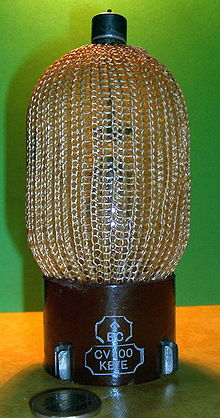Trigatron
A Trigatron is a triggerable spark gap , often designed as a gas-filled electron tube , for switching short high-voltage pulses of high power. With larger tubes, very high voltages in the range of a few 10 kV and pulse currents of a few 1 kA are switched, which corresponds to pulse powers of up to a few megawatts and can not be achieved with electromechanical switches . The Trigatron was developed by the British during World War II : In radar systems , direct voltage pulses were converted into high-frequency pulses using a magnetron . Another application is in the Marx generator . The Trigatron is still used in pulse electronics today.
construction
The Trigatron has three electrodes : two unheated, mushroom-shaped main electrodes as anode and cathode as well as an ignition electrode, which is usually located in a central hole in the anode. The distance between the two main electrodes is chosen to be so large that there is no voltage breakdown. A small spark between the ignition electrode and anode generates charge carriers locally through ionization and photoelectrons via ultraviolet radiation at the cathode , which immediately leads to the ignition of an arc between the two main electrodes. The trigatron is switched off indirectly, in that a pulse-forming passive network ensures that the holding current is not reached and the arc is extinguished.
Small to medium-sized tubes are filled with various gases such as a mixture of 93% argon and 7% oxygen , nitrogen , or sulfur hexafluoride (SF 6 ) and are under a pressure of 1 bar to approx. 3.5 bar. For high performance, the gas filling is replaced by electrically non-conductive liquids such as transformer oil , a form of pure mineral oil. Early types of the Trigatron without gas exchange are designed for up to 10,000 switching cycles. There are also older tubes which are only designed for a few switching cycles. At the end of the service life of these historical designs, the glass bulb was destroyed, which is why it is surrounded by a fine-meshed net to catch the splinters. In today's standard Trigatron with a number of cycles of over a million, the piston consists of a correspondingly massive housing, the gas filling is exchanged during operation through appropriate supply connections, and the construction of the housing prevents it from bursting.
The thyratron is a further development of the trigatron, but with rectifying properties and a heated cathode .
Individual evidence
- ↑ Trigatron , Tubecollection, October 22, 2008, accessed on September 9, 2010
- ↑ a b Specifications for SG-Series Spark-Gap Switches (PDF; 973 kB), technical description, company publication RE Beverly III and Associates, requested on September 10, 2010, (English)
Web links
- Spark gap and triggered gap tubes , (engl.)

